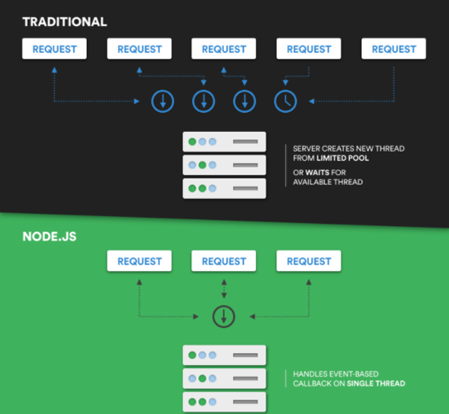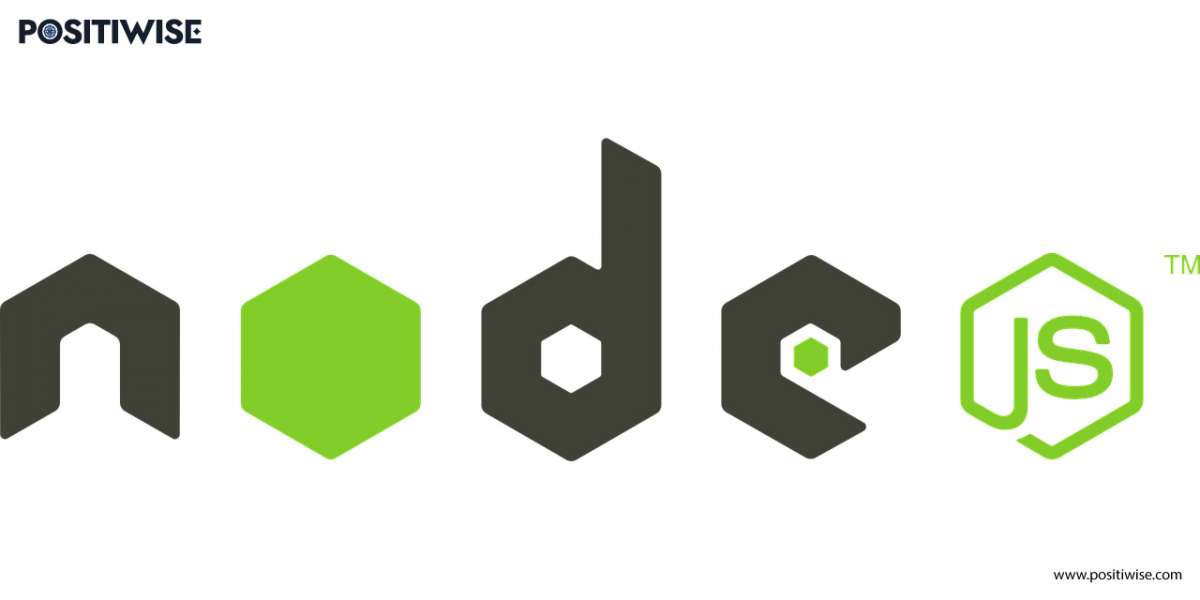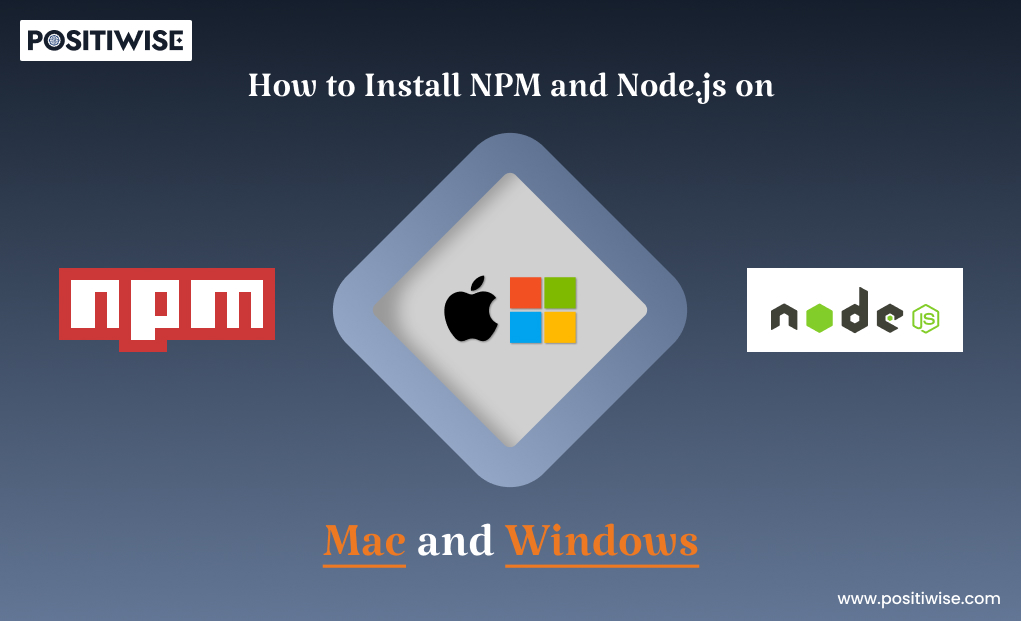Quick Overview:
While developing an application, selecting a backend technology is considered a time-consuming task.
But, with the introduction of Node JS, many developers directly select it due to its modular architecture and high-performing capabilities in intense environments. As a result, Node JS is now a part of the central web development stacks.
Having top-notch tech as your backend assures your users have a seamless experience and promises to maintain security and fulfill the dynamic business requirements.
And Node JS technology offers us all these features.

Moreover, as per the latest statistics, Node JS usage in 2022 is rapidly increasing, with 0.54% daily, and top companies, such as Twitter and Netflix, are using it as their backend.
So, let’s find out everything about it and where you can learn it by reading further in this Node JS development guide.
What is Node JS, and Why is it used?
Node JS is a runtime environment designed to build and run extendable network-based business solutions.
It follows an asynchronous event-driven architecture, leading the application to handle many user requests simultaneously without affecting the quality and performance.
You can build a variety of scalable, secure, and robust applications with it.
Primarily, developers use it as a server-side technology due to its non-blocking and real-time structure, optimizing the speed and internal app’s functionality. In addition, it allows quick updates and fixes, helping organizations efficiently meet their business goals.
When you implement Node JS as your software’s backend, you can be hassle-free from the worry of deadlocking. It doesn’t perform I/O directly, which leverages the customer to have a seamless experience.
Moreover, it supports the JavaScript language to aid the developers in building a business-oriented solution with a shorter time to market and for embedding every essential feature in it.
You can use Node JS for various software projects. So, let’s have a look at them.
- IoT Applications provide a single interface for configuring and maintaining various smart devices in the network.
- For applications with the requirement of having microservice architecture
- Real-time chatbots and collaboration systems for enterprises
- Video streaming applications, such as Netflix and Amazon Prime
- Payment Services, such as Razor Pay
- Single Page and Social Media Apps
Recommended Read: What’s New in Node.Js 19?
A Descriptive Node JS Development Guide for Your Software Projects
Node JS Architecture
Node JS has one of the most scalable and flexible architectures, providing many benefits to your application.
Mainly, there are two types of backend architectures: multi-threaded and traditional. And the second is single-threaded, which Node JS follows. Both are unique, and engineers configure them as per the project goals and technical requirements.
We are moving on to the Node JS architecture. It follows the single-thread approach, in which a single element or thread receives all the user requests, but there are multiple events in the background, processing every instruction simultaneously.
As a result, your application can handle heavy user traffic, maintain its speed, and guarantee accurate output to end-users. Moreover, it uses low system memory and maximum potential to shorten the time for processing each request.
Now, you must consider how it is better than the multi-thread mechanism and how a single thread can beat the power of multiple threads.
Let’s clarify it too. In the multi-threaded architecture, there is a limit of threads. When the server receives a new request, it assigns that instruction to a new thread. When a user provides another input, it sets that to another thread.
Likewise, the process goes on and on. Once all the threads are busy but requests come from client devices, the server stops responding and even leads to total failure or crash.
That’s how Node JS architecture aids in maintaining the data flow and application productivity.

How is Node JS better than other Backend Technologies?
Now, you know the internal working of Node JS, and you can consider it one of the reasons for its adaption and popularity.
But, there can still be some confusion or questions about why you should prefer it only based on a seamless architecture functioning.
Let’s get straight to the answer, how Node JS is better than other major backend technologies.
- It uses JavaScript as its primary programming language and offers the features to create a network-based application quickly.
- Most backend technologies use a synchronous mechanism, but Node JS utilizes Asynchronous operations to process user requests.
- Using the same language for both client-side and server-side can increase compatibility and enable users to access the application across operating systems and devices.
- It reduces the developer’s effort by providing documentation about installing and configuring every component. You can quickly access it by clicking here.
- It helps build feather-light applications with every crucial API, plugin, feature, and component necessary for large-scale business solutions.
Pros of Node JS
- NPM Package Manager
- Non-Blocking Input/output
- Code Reusability
- Affordable Development
- Ample Community Support
- High-Performance and Scalability
NPM Package Manager
For installing Node JS on your system, you will require Node Package Manager, which contains all the vital modules and dependencies.
NPM is one of the main advantages of Node JS, as it eliminates the task of downloading external tools and components., which saves time and leads to quickly moving further to the development stage. In addition, you can use NPM to handle different versions of code and manage the globally-installed instances.
Non-Blocking Input/output
Node JS works upon the principle of asynchronous and event-driven architecture and uses a single thread for executing multiple client instructions.
Due to this, the application can handle high traffic without impacting performance, speed, and security. Also, it consumes less computing power as compared to the synchronous mechanism.
Moreover, it will optimize your application’s responsiveness, latency, and throughput, making it flawlessly accessible over a low-bandwidth connection.
Code Reusability
Reusing a code has various benefits, and one of its benefits is reducing the developer’s effort, as it directly minimizes the project budget.
Node uses JavaScript, leveraging the engineers to utilize it for another project.
For instance, if you have built a component for validating the user input, you can take that piece of code and add it to the source code of another application. It will work efficiently and doesn’t affect the functioning.
Affordable Development
You can develop your Node JS application on a minimal budget. You don’t have to pay anything for accessing, downloading, and installing the NPM on your Windows and macOS machines.
In addition, there are plenty of learning resources and pre-developed source codes, which you can quickly access without paying any fee. Also, you can find plenty of Node JS specialists at reasonable prices to collaborate with you on a software development project.
Ample Community Support
Having a community significantly benefits getting the answers to your queries.
Node JS has an extensive community of software developers, researchers, and enthusiasts, who perform daily analysis on its components and add new updates.
Also, if you are stuck in between configuring any element in your application, you can post your query and expect a reply from the community members in a short time. It can help you to fast-forward the software fabrication.
High-Performance and Scalability
With Node JS as your backend technology, you can assure your users’ maximum uptime and faster speed. Non-Blocking I/O and asynchronous architecture lead the software to execute extensive instructions at once and promise to provide relevant output to every user.
In addition, it offers in-built APIs and plugins for configuring network protocols, such as DNS and HTTPS, for maintaining data integrity, confidentiality, and availability.
Cons of Node JS
- Delay of Output in exceptional circumstances
- Lack of Stable Tools
Delay of Output in exceptional circumstances
Yes, you read it right. Whether it has an event-driven asynchronous architecture, it can take more time to perform heavy computational operations.
If your application needs to perform multiple analyses and process a large amount of data using advanced mathematical calculations, you should prevent using Node JS.
Lack of Stable Tools
APIs, plugins, and widgets for Node JS are still under development, making your application unstable due to frequent code modification. Before integrating any external element, you must always check its compatibility, then only adjoin it in the software.
When to avoid Development using Node JS Technology
In 2022, applications are becoming more scalable and real-time oriented. So, you must know which applications you should avoid using Node JS, as selecting an incompetent technology can lead to app crashes, more bugs, and security breaches.
- It will help if you avoid fabricating apps processing large data.
- Developers must prevent Node JS while integrating a relational database with the business solution.
- Never select it for software, receiving instructions directly from the server, as it can slow down the process.
You must avoid using the above-listed type of application. Otherwise, you can face app crashes, errors, and interruptions between navigating from one page to another.
Where to learn Node JavaScript
To effectively implement technology in your software project, you must have its basic to advanced knowledge, and the same is the case with Node JS.
To learn about the functioning and configuration of Node JS, you can register yourself in the online courses or the training modules available on the official Node JS website. Further, after completing all the lessons, you can take the Open Node.js Services Developer exam, which will help you to exaggerate your career growth.
In addition, you read blogs and opt for professional courses on Khan Academy, Udemy, Coursera, and many more online educational platforms. You can earn certificates and work on live projects with the course, do your assignments, and showcase your skills online.
Additionally, there are a lot of YouTube channels providing content for learning backend technologies. You can freely learn from there and enhance your Node JS skills in no time.
You have to be consistent in learning to achieve your goals.
Let Our Experts Build the Web App You Need
Struggling to find an off-the-shelf solution that fits your needs? Our experienced web developers create custom apps designed specifically for your business goals. Leverage our expertise to get the precise web app you want.

Concluding Up
Node JS is JavaScript-based server-side technology having the capability of handling multiple user requests through its single-threaded architecture.
For the past three to four years, it has been gaining popularity, and it is now a part of every major development stack, such as MEAN and MERN. You can utilize Node JS for small, medium, and large-scale projects where extensive user traffic is probable, but logic is not complex.
Besides this, if you are a beginner or an industry expert, you can still enhance your Node JS theoretical and practical knowledge by enrolling yourself in an online masterclass.
You can also achieve the certificate for having an outstanding skillset in configuring network-based applications.
Node JS is gaining pace, and it’s the right time to learn about it.
Expert in Marketing Strategy and Brand Recognition
Jemin Desai is Chief Marketing Officer at Positiwise Software Pvt Ltd, he is responsible for creating and accelerating the company’s marketing strategy and brand recognition across the globe. He has more than 20 years of experience in senior marketing roles at the Inc. 5000 Fastest-Growing Private Companies.






